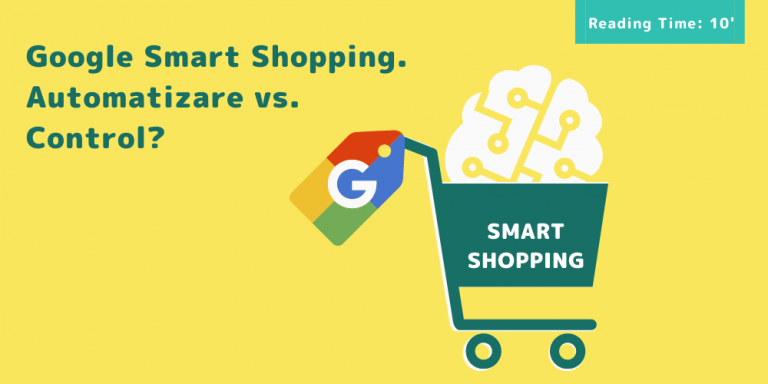Google Smart Shopping. Automation vs. Control?

Currently, the online retail / ecommerce market tends to become automated when it comes to Google PPC campaigns. Given the large number of products, with dozens of variables (stock, variations, models, etc.), it is not surprising that a product like Google Smart Shopping is becoming increasingly used detrimental to standard search or display campaigns.

Since the beginning, the structure of a smart shopping campaign is simple, easy to use and implement. This simplicity, however, comes with a few drawbacks – more precisely, a lack of control for the marketer. Unlike a standard shopping or search campaign, where you can adjust several settings (target and placement, granular bid adjustment, the possibility of applying negative keywords and custom schedule) – the Smart Shopping campaign offers an automation system of delivery and bid not exactly transparent.
Read about automation trends in 2021 here
Advantages
The distinct advantage of a Smart Shopping campaign is Google’s artificial intelligence algorithm, a system that is based on maximizing conversion value, controlled or not by ROAS. This system targets the user who is most likely to convert now and who converts with the maximum possible ROAS.
In addition, the algorithm also falls into the remarketing field. It synchronizes a user’s searches and browsing history with search terms and delivers a “warm” result / product already viewed, thus strengthening the purchase decision and the chance of conversion.

At first sight, this Smart Shopping system brings a welcome automation in the field of PPC -especially when it comes to a retailer or business with a large product portfolio or many advertising campaigns.
The lack of control is complemented or counteracted by the objective-based sales strategy, namely ROAS.
Disadvantages
First of all, a Smart Shopping campaign needs a history of conversions (transactions) in order to work and reach its maximum potential. For this reason, this type of campaign is not recommended for new accounts. The algorithm compares and analyzes conversions on the account (whether it’s revenue or audience) and optimizes propagation based on this history – therefore, campaign performance is strictly related to the accuracy of this data.
Being fully automated, there cannot be seen or used multiple metrics that are useful for in-depth optimization for a Google Ads account, such as: search terms, negative keywords, targeting or audience data, placements data, and lack of control for granular bidding.
What else does the marketer have to do?
Although the campaign is fully automated, it still needs to be optimized and monitored. In this type of campaign, these things can be done by adjusting the budget (we recommend a maximum increase / decrease between 10-15% at each optimization), adjusting ROAS according to the performing products or segmenting them in another Smart Shopping campaign with separated ROAS.
For example:
A product that brings conversions and has a high profit margin can be set to a lower ROAS than history to attract even more conversions.
On the other hand, a product with low profit margin can be set to a higher ROAS, so that it is profitable when purchased, even if it does not have so many conversions.
The strategy moves to the type and categories of products and it is recommended to divide them into performance bases, not conversion number bases.
The best indices for measuring historical performance are: Clicks, Impressions, Average CPC , Conversions, ROAS, COS + Click Share, Search Impression Share – and if available, Benchmark CPC, Landing page experience and Bounce rate (Sync with Google Analytics).
From these metrics we can realize the performance and relevance of the products in the campaign and we can optimize to increase performance.
Having a large portfolio of products with concrete information (price, stock, profit margin, etc.) can create a high-performance automation strategy, segmented and controlled only by budget, product split and product yield – all related to the ecommerce environment.
Naturally, optimization moves more on the Merchant Center product feed, landing page experience, and product relevance in search results.
Best Practices optimization guide
In addition to the initial recommendations of the Google Merchant Center, optimization is also done according to Google best practices. Here are some of them:
- Use a simple product and image URL that Google can easily crawl. (Avoid symbols or punctuation marks);
- Avoid discrepancies between product details in the feed and those on the landing page (same image, same price, same title and same description);
- Use an 800x800px image, with a white or transparent background, without other logos or additional graphics. The product must also be framed and clearly defined, without any other products or elements around it. For other product settings, additional images can be set in the optional field [additional_image_link];
- Use high quality images of product, without effects or filters, not pixelated or edited (blur, warp, enhance etc);
- Set rules in the feed to exclude out-of-stock products, without image, title or description. We also recommend advertising only products that are in stock, not pre-ordered products (this may decrease the rate of interaction and correct propagation of the feed) – Google will prioritize products that are in stock;
- Avoid excessive capitalization in the title or description;
- Use a GTIN code instead of MPN. Google recommends this and informs that products with GTIN code have up to 40% more displays and clicks;
- Use a GTIN code instead of MPN. Google recommends this and informs that products with GTIN code have up to 40% more displays and clicks;
- Use a maximum of 25 characters for title and a maximum of 90 characters for description. When writing a title or description, it is recommended to use a keyword structure (eg. Brand + model / product + attribute – Nike Sport Leather / Basketball Shoes).
We are available at any time for a consultation on how you can optimize your smart shopping campaigns – and more.





